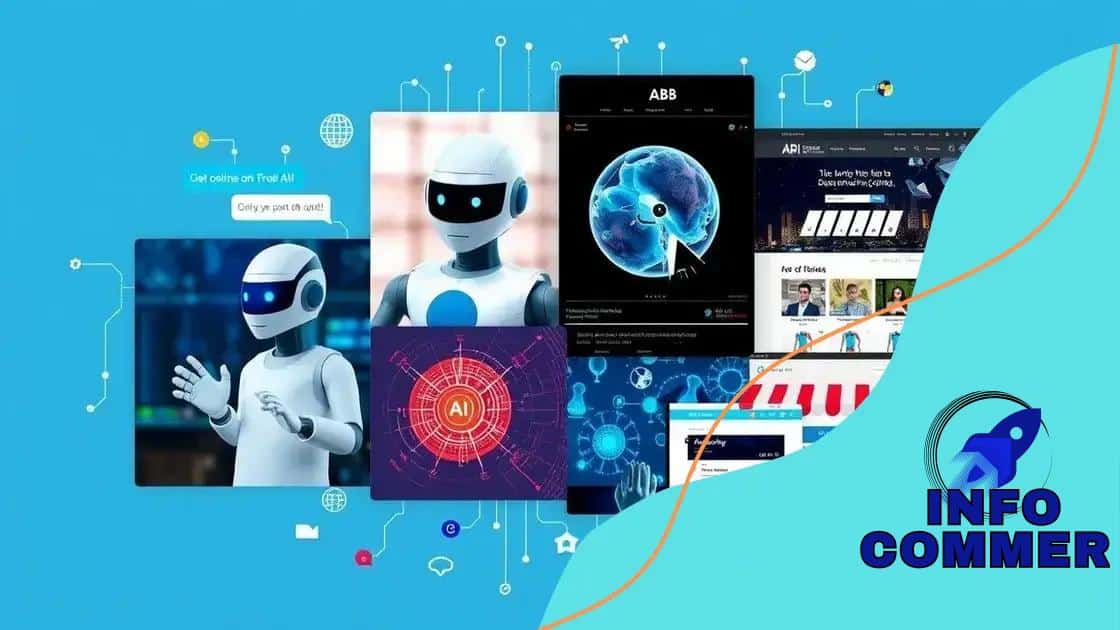How AI is revolutionizing personalized customer experiences

AI is revolutionizing personalized customer experiences by utilizing data analysis to offer tailored interactions, enhance engagement, and streamline service efficiency across multiple platforms.
How AI is revolutionizing personalized customer experiences is an exciting topic, don’t you think? Imagine receiving tailored recommendations just for you! In a world where one-size-fits-all no longer applies, AI steps in to create unique interactions that can enhance our daily lives.
Understanding AI and its role in customer service
Artificial Intelligence (AI) plays a crucial role in enhancing customer service experiences. It is transforming the way businesses interact with their customers and provides opportunities for personalized engagement. But how exactly does AI accomplish this?
Key Features of AI in Customer Service
Utilizing AI enables companies to offer real-time assistance and tailor interactions based on individual preferences. With the ability to analyze vast amounts of data, AI technology can identify patterns and provide insights that help improve customer satisfaction significantly.
- 24/7 Availability: AI allows businesses to offer round-the-clock support, ensuring that customers receive assistance whenever they need it.
- Personalized Interactions: By leveraging machine learning, AI can tailor responses and recommendations based on individual customer behavior.
- Efficient Problem Solving: AI systems can quickly analyze issues and provide solutions, reducing wait times for customers.
- Scalability: Implementing AI enables companies to manage a high volume of inquiries without losing the quality of service.
Furthermore, AI tools such as chatbots and virtual assistants are particularly valuable for automating repetitive tasks. These technologies respond instantly to queries, allowing human agents to focus on more complex issues. For instance, when a customer asks about product specifications, a chatbot can provide accurate details in seconds.
Additionally, businesses can refine their customer support strategies by analyzing data collected from AI interactions. This data helps identify common questions, allowing businesses to create insightful FAQs or enhance training programs for employees. As AI continues to learn, the quality of service will only improve.
In the world of customer service, embracing AI isn’t just an option; it’s becoming essential. By enhancing efficiency and personalizing the customer experience, companies can build stronger relationships with their clientele.
How AI personalizes user experiences
AI is changing the way companies interact with users, making experiences feel more personal and engaging. By understanding individual preferences, AI can provide recommendations that are tailored specifically to each user.
Personalization Techniques
One of the powerful ways AI personalizes experiences is through data analysis. By examining user behavior, AI can suggest products or services that align with what a user is likely to enjoy. This is often seen in e-commerce platforms, where suggestions pop up based on previous purchases.
- Behavior Tracking: AI analyzes browsing and purchase history to recommend relevant options.
- Targeted Marketing: Businesses use AI to send personalized emails or notifications based on user interests.
- Dynamic Content: Websites can adjust their content in real-time to match user behavior, creating a unique experience for each visitor.
- Feedback Loops: AI learns from user feedback to continually improve personalization efforts.
This personalization creates a deeper connection between users and brands, leading to increased loyalty and satisfaction. Imagine visiting a streaming service that instantly knows which shows you might like based on previous viewing habits. This form of customized interaction enhances user engagement significantly.
Moreover, AI can improve user experiences through chatbots. By analyzing questions and responses, these virtual assistants can provide tailored advice quickly, addressing user needs effectively. For example, a chatbot might recommend specific articles based on what a user has read before.
Businesses also benefit from the insights provided by AI. By understanding customer preferences, they can invent new products that resonate with their audience. Continuous learning from AI systems means that the level of personalization becomes even more precise over time.
Real-life examples of AI in action

Real-life examples of AI show how this technology is transforming various industries. Companies across the globe are harnessing the power of AI to improve efficiency, enhance customer experiences, and drive innovation.
Customer Service Innovations
Many organizations utilize AI chatbots to provide immediate assistance to customers. These chatbots handle common inquiries, allowing human agents to focus on more complex issues. For instance, a major telecommunications company uses an AI-driven chatbot that resolves customer queries in real-time, improving response times and satisfaction ratings.
- Healthcare: AI analyzes medical data to assist doctors in diagnosing conditions early, leading to better patient outcomes.
- Retail: Online retailers use AI to recommend products based on user behavior, increasing sales and enhancing user engagement.
- Finance: Financial institutions employ AI algorithms to detect fraudulent transactions instantly, protecting customers from potential losses.
- Transportation: Companies like Uber utilize AI to optimize ride-sharing routes, ensuring faster travel times for customers.
In the healthcare field, AI applications are expanding rapidly. For example, some hospitals use AI tools to analyze medical imaging, leading to faster and more accurate diagnoses. AI systems evaluate x-rays and MRIs, highlighting areas of concern for doctors’ review.
Moreover, the finance sector benefits greatly from AI. Banks use machine learning algorithms to assess risk levels for loan applications and investments. This analysis helps minimize defaults and enhances profitability by providing tailored services to clients.
Retailers are taking advantage of AI to create personalized shopping experiences. By analyzing customer data, they can suggest items that align with individual preferences. This is evident in well-known e-commerce platforms, where users receive tailored product recommendations based on their browsing history.
Challenges of implementing AI solutions
Implementing AI solutions comes with its own set of challenges. Organizations must navigate a variety of obstacles to fully embrace the potential of AI technology. Understanding these challenges is crucial for successful integration.
Data Quality and Availability
One of the primary hurdles in adopting AI is ensuring that the data used is both high-quality and readily available. Poor data can lead to inaccurate results, undermining the effectiveness of AI models. Companies must invest in data cleaning and management processes to ensure that they can train AI systems effectively.
- Inconsistent Data: Having different formats or definitions can confuse AI algorithms.
- Insufficient Volume: AI models require enough data to learn effectively; lacking data can hinder performance.
- Bias in Data: If the training data is biased, the AI solution may also develop biased outcomes.
- Security Concerns: Safeguarding sensitive data while using it for AI training is crucial.
Additionally, technical skills are essential for implementing and maintaining AI systems. Many organizations face a talent shortage in the field of AI. Hiring experts who can develop, deploy, and refine AI technologies is crucial for success.
Another significant challenge is resistance to change within the organization. Employees may be hesitant to accept AI solutions due to fears of job loss or mistrust of the technology. It is important for leadership to communicate clearly about the benefits of AI and involve team members in the integration process.
Moreover, integration with existing systems can pose technical challenges. Companies often utilize legacy systems that may not easily adapt to new AI solutions. Ensuring compatibility and a seamless transition requires careful planning and investment.
Future trends in AI-driven customer interactions
The future of AI-driven customer interactions is bright and full of potential. As technology evolves, businesses are set to transform their engagement strategies significantly. Understanding upcoming trends is essential for companies aiming to stay competitive.
Enhanced Personalization
In the coming years, AI will enable even greater personalization in customer interactions. Businesses will analyze customer data more comprehensively, tailoring experiences based on individual preferences and behaviors far beyond what is currently possible. For example, imagine a shopping platform that customizes the entire user interface based on prior purchases, style preferences, and even browsing times.
- Predictive Analytics: AI will use predictive analytics to anticipate customer needs before they even arise.
- Sentiment Analysis: Customers’ feelings and opinions will be gauged in real-time, allowing for immediate adjustments in service.
- Dynamic Recommendations: Product suggestions will adapt instantly as the customer interacts with the site, creating a fluid purchasing journey.
- Voice and Visual Search: Customers will increasingly use voice commands and visual searches, requiring businesses to adapt their AI services accordingly.
Moreover, AI will enhance multi-channel interactions. Customers are using various platforms to engage with brands. AI will allow businesses to provide seamless experiences across different channels, including social media, websites, and mobile apps. This will ensure that no matter where a customer interacts, they receive consistent service.
Automation will also play a crucial role in shaping future customer service roles. Routine tasks will be fully managed by AI, freeing up human agents to tackle more complex or sensitive issues. For example, chatbots will handle standard inquiries, enabling staff to spend more time on higher-value interactions.
Additionally, feedback loops will be tighter and more efficient due to AI. Businesses will harness real-time data to assess customer satisfaction and rapidly iterate on their services. With AI analyzing interactions, companies can quickly modify their approaches based on direct customer feedback.
FAQ – Frequently Asked Questions about AI and Customer Interactions
How does AI enhance customer personalization?
AI analyzes customer data to offer tailored experiences and recommendations based on individual preferences.
What are the main challenges of implementing AI solutions?
Common challenges include data quality, lack of technical skills, and resistance to change within the organization.
How can businesses benefit from AI-driven automation?
AI automation can handle routine tasks, allowing human agents to focus on complex customer interactions and improve overall efficiency.
What future trends can we expect in AI customer interactions?
We can expect enhanced personalization, improved multi-channel experiences, and real-time sentiment analysis to gauge customer satisfaction.





